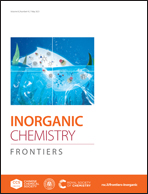Coordination assembly and host–guest chemistry of a triply interlocked [2]catenane†
Abstract
Triply catenated systems are highly intricate topologies that consist of two identical, mechanically interlocked coordination cage components with intriguingly complex architectures. A few triply interlocked catenanes have been successfully synthesized to date, but how to controllably construct the aesthetic topologies and study their host–guest properties is still a tough challenge. Herein, taking advantage of rational strategies, we reported the efficient construction of a triply interlocked [2]catenane with the formula [(Cp*Rh)12B6L4](OTf)12, wherein both the discrete metal-coordination cages were mutually interlocked through mechanical bonds. A series of characterization techniques were employed to confirm the formation and structure of the desired triply interlocked system: multinuclear NMR spectroscopy, ESI-MS, and single-crystal X-ray diffraction analysis. The solid-state structure of [(Cp*Rh)12B6L4](OTf)12 unambiguously confirmed the existence of a triply interlocked catenane that consisted of two identical, mechanically interlocked hexanuclear metal-coordination cage components. Interestingly, in solution, the catenated topology can be transformed into a monomer induced by host–guest interactions and external stimuli like UV-visible light. Furthermore, we systematically studied its host–guest properties for potential applications in drug delivery systems.
![Graphical abstract: Coordination assembly and host–guest chemistry of a triply interlocked [2]catenane](/en/Image/Get?imageInfo.ImageType=GA&imageInfo.ImageIdentifier.ManuscriptID=D1QI00174D&imageInfo.ImageIdentifier.Year=2021)


 Please wait while we load your content...
Please wait while we load your content...